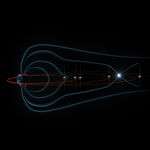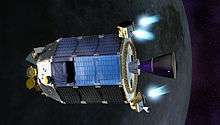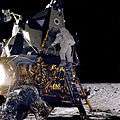THEMIS
|
THEMIS in Delta II fairing | |
| Mission type | Magnetospheric research |
|---|---|
| Operator | NASA |
| COSPAR ID | 2007-004 (A, B, C, D, E) |
| SATCAT № | 30580, 30581, 30582, 30583, 30584 |
| Website |
themis |
| Mission duration | elapsed: 9 years, 9 months and 29 days |
| Spacecraft properties | |
| Manufacturer | Swales Aerospace |
| Launch mass | 630 kilograms (1,390 lb) |
| Dry mass | 77 kilograms (170 lb) each |
| Power | 37.0 W each |
| Start of mission | |
| Launch date | 17 February 2007, 23:01:00 UTC |
| Rocket | Delta II 7925-10C |
| Launch site | Cape Canaveral SLC-17B |
| Orbital parameters | |
| Reference system | Geocentric |
| Regime | Highly Elliptical |
| Eccentricity | 0.8637973070144653 |
| Perigee | 470 kilometres (290 mi) |
| Apogee | 87,330 kilometres (54,260 mi) |
| Inclination | 16.0° |
| Period | 1,870 minutes |
The Time History of Events and Macroscale Interactions during Substorms (THEMIS) mission was originally a constellation of five NASA satellites (THEMIS A through THEMIS E) to study energy releases from Earth's magnetosphere known as substorms, magnetic phenomena that intensify auroras near Earth's poles. The name of the mission is an acronym alluding to the Titan, Themis.[1]
Three of the satellites remain in the magnetosphere, while two have been moved into orbit near the Moon. Those have been renamed ARTEMIS for Acceleration, Reconnection, Turbulence and Electrodynamics of the Moon’s Interaction with the Sun. THEMIS B became ARTEMIS P1 and THEMIS C became ARTEMIS P2.[2]
The THEMIS satellites were launched February 17, 2007 from Cape Canaveral Air Force Station Space Launch Complex 17 aboard a Delta II rocket.[1][3] Each satellite carries identical instrumentation, including a fluxgate magnetometer (FGM), an electrostatic analyzer (ESA), a solid state telescope (SST), a search-coil magnetometer (SCM) and an electric field instrument (EFI). Each has a mass of 126 kg, including 49 kg of fuel.[4]
THEMIS data can be accessed using the SPEDAS software.
Launch
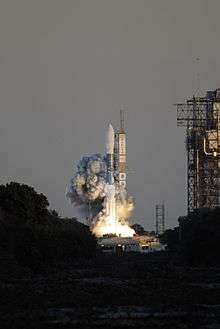
THEMIS was originally scheduled to launch on October 19, 2006. Owing to delays caused by workmanship problems with Delta II second stages—an issue that also affected the previous mission, STEREO—the THEMIS launch was delayed to Thursday, February 15, 2007. Due to weather conditions occurring on Tuesday, February 13, fueling of the second stage was delayed, and the launch pushed back 24 hours. On February 16, the launch was scrubbed in a hold at the T-4 minute point in the countdown due to the final weather balloon reporting a red, or nogo condition for upper level winds. A 24-hour turnaround procedure was initiated, targeting a new launch window between 23:01 and 23:17 UTC on February 17.
Favorable weather conditions were observed on February 17, and the countdown proceeded smoothly. THEMIS successfully launched at 6:01 p.m. EST. The spacecraft separated from the launch vehicle approximately 73 minutes after liftoff. By 8:07 p.m. EST, mission operators at the Space Sciences Laboratory (SSL) of the University of California, Berkeley, commanded and received signals from all five spacecraft, confirming nominal separation status.
The launch service was provided by the United Launch Alliance through NASA Launch Services Program (LSP).
Mission status
From February 15, 2007 until September 15, 2007 the five THEMIS satellites coasted in a string-of-pearls orbital configuration. From September 15, 2007 until December 4, 2007 the satellites were moved to more distant orbits in preparation for data collection in the magnetotail. This phase of the mission was called the "Dawn Phase" because the satellites' orbits were in apogee on the dawn side of the magnetosphere. On December 4, 2007 the first tail science phase of the mission began. In this segment of the mission scientists will collect data from the magnetotail of the Earth's magnetosphere. During this phase the satellites' orbits are in apogee inside the magnetotail. The scientists hope to observe substorms and magnetic reconnection events. During these events charged particles stored in the Earth's magnetosphere are discharged to form the aurora borealis. Tail science is performed in the winter of the northern hemisphere because the ground magnetometers that Themis scientists correlate the satellite data with have relatively longer periods of night. During the night, observations are not interrupted by charged particles from the Sun.[5]
In 2007, THEMIS "found evidence of magnetic ropes connecting Earth's upper atmosphere directly to the Sun," reconfirming the theory of solar-terrestrial electrical interaction (via "Birkeland currents" or "field-aligned currents") proposed by Kristian Birkeland circa 1908.[6][7] NASA also likened the interaction to a "30 kiloVolt battery in space," noting the "flux rope pumps 650,000 Amp current into the Arctic!"[8]
On 26 February 2008, THEMIS probes were able to determine, for the first time, the triggering event for the onset of magnetospheric substorms.[9] Two of the five probes, positioned approximately one third the distance to the Moon, measured events suggesting a magnetic reconnection event 96 seconds prior to Auroral intensification.[10] Dr. Vassilis Angelopoulos of the University of California, Los Angeles, who is the principal investigator for the THEMIS mission, claimed, "Our data show clearly and for the first time that magnetic reconnection is the trigger."[11]
| THEMIS images and multimedia | ||||||||
|---|---|---|---|---|---|---|---|---|
|
Extended mission
On May 19, 2008 the Space Sciences Laboratory (SSL) at Berkeley announced NASA had extended the THEMIS mission to the year 2012. NASA officially approved the movement of THEMIS B and THEMIS C into lunar orbit under the mission name ARTEMIS (Acceleration, Reconnection, Turbulence and Electrodynamics of the Moon's Interaction with the Sun).
ARTEMIS

As of spring 2010, ARTEMIS P1 (THEMIS B) has performed two Lunar flybys and one Earth flyby, and was approaching insertion into a Lissajous orbit around a Lunar Lagrange point. Lunar orbit insertion was targeted for April 2011. ARTEMIS P2 (THEMIS C) completed a Lunar flyby and was on the inbound leg of the first of three deep space excursions on its way to a Lissajous orbit and was targeted for Lunar orbit in April 2011.[12]
On June 22, 2011, ARTEMIS P1 began firing its thrusters to move out of its kidney-shaped "libration" orbit on one side of the Moon, where it had been since January.[13] As of July 2, 2011 12:30 p.m. EDT, ARTEMIS P1 achieved lunar orbit. The second spacecraft, ARTEMIS P2, moved into lunar orbit as of July 17, 2011.[14] Along the way, the two spacecraft were the first to ever achieve orbit around the Moon's Lagrangian points.[13][15]
As of November 2013, both probes are in very stable orbits, and the health of all instruments and the spacecraft remains very good.[16]
Instruments
Aboard the spacecraft
- Instrument Data Processing Unit (IDPU): The IDPU houses most of the electronics for the instruments on the THEMIS spacecraft.
- Electric Field Instruments (EFI): The EFI is designed and built to sense the electric field in Earth's ever-changing magnetosphere
- Fluxgate magnetometer (FGM): The FGM measures the background magnetic field to identify and time the abrupt reconfigurations of the magnetosphere during substorm onset.
- Search-coil magnetometer (SCM): The SCM measures low frequency magnetic field fluctuations and waves in three directions in Earth's magnetosphere.
- Electrostatic Analyzer (ESA): The ESA measures thermal electrons and ions to identify and track high-speed flows through the magnetotail and identify pressure pulses.
- Solid State Telescope (SST): The SST measures energetic particle distribution functions.
- Digital Fields Board (DFB): The DFB uses an FPGA to perform configurable on-board band pass processing and fast Fourier transformations(FFT) on instrument data.
Ground based
As the satellites monitor the magnetosphere from orbit, twenty ground stations in North America simultaneously monitor auroras. Ground station mission and science operations are being managed by the University of California Space Sciences Laboratory.
- Ground-Based All-Sky Imager (ASI) Array: The ground-based All-Sky Imager (ASI) array observes the aurora over the Northern American continent from Canada to Alaska in order to determine where and when the auroral substorm onset occurs.
- Ground-Based Magnetometer (GMAG) Array: The GMAG Measure changes in Earth’s magnetic field near Earth’s surface due to substorm onset to help determine the timing of substorm events.
Swales Aerospace
Swales Aerospace, now part of Orbital ATK, (Beltsville, Maryland) manufactured all five probes for this mission. Each was built-up and tested at the Beltsville facility, before being delivered to University of California, Berkeley for instrument integration. Swales was responsible for integrating the BAU, IRU, Solar Arrays, Antenna, Battery, and other components necessary for functionality. This was the second major satellite built by Swales, the first being the EO-1 spacecraft, which continues to orbit Earth. Swales was also responsible for designing and building the Electrical Ground Support Equipment (EGSE) used for monitoring the probes during all phases of pre-launch activities, including use at the launch site.
JPL
After the installation of instruments at SSL, Berkeley, pre-launch testing including thermal-vac, vibration and acoustic tests, was conducted at NASA's Jet Propulsion Laboratory in Pasadena, California.
FAST
The Fast Auroral Snapshot Explorer (FAST) mission supported THEMIS in 2008 and 2009 before being retired.[17] FAST was a Small Explorer program (SMEX) mission launched in 1996.[17]
See also
Lists of relevant topics
- List of active Solar System probes
- List of heliophysics missions
- List of objects at Lagrangian points
- List of Solar System probes
- List of space telescopes
- Timeline of Solar System exploration
- SPEDAS software for space physics data
Other relevant spacecraft
- Advanced Composition Explorer (ACE), launched 1997, still operational.
- Cassini–Huygens
- Cluster (spacecraft)
- Double Star (satellite) launched on Cluster.
- Helios (spacecraft)
- MESSENGER (MErcury Surface, Space ENvironment, GEochemistry and Ranging), launched 2004, impacted on Mercury on April 30, 2015.
- Van Allen Probes
- Solar Dynamics Observatory (SDO), launched 2010, still operational.
- Solar and Heliospheric Observatory (SOHO), launched 1995, still operational.
- Solar Maximum Mission (SMM), launched 1980, decommissioned 1989.
- Solar Orbiter (SOLO), set to launch in 2015.
- Solar Probe Plus, set to launch in 2015.
- STEREO (Solar TErrestrial RElations Observatory), launched 2006, still operational.
- Transition Region and Coronal Explorer (TRACE), launched 1998, decommissioned 2010.
- Ulysses (spacecraft), launched 1990, decommissioned 2009.
- WIND (spacecraft), launched 1994, still operational.
- ELFIN (Electron Losses and Fields INvestigation), set to launch in 2017.
References
- 1 2 Lynn Jenner (28 May 2009). "THEMIS Mission Pages". NASA. Retrieved 2009-12-02.
- ↑ Phillips, Tony. "Dead Spacecraft Walking". ARTEMIS mission site. NASA. Retrieved 28 June 2011.
- ↑ Justin Ray (18 February 2007). "Mission Status Center: THEMIS". SpaceFlight Now. Retrieved 2009-12-02.
- ↑ World Data Center for Satellite Information (1 March 2007). "SPACEWARN Bulletin, No. 640". National Space Science Data Center. Retrieved 2009-12-02.
- ↑ Space Sciences Laboratory (2009). "Themis Orbits". UC Berkeley. Retrieved 2009-12-02.
- ↑ Cynthia O'Carroll (11 December 2007). "NASA Spacecraft Make New Discoveries About Northern Lights". Goddard Space Flight Center. Retrieved 2009-12-02.
- ↑ Tony Phillips (20 March 2008). "Spring is Aurora Season". Science@NASA. Retrieved 2009-12-02.
- ↑ Cynthia O'Carroll (7 December 2007). "Multimedia for the Press Event for THEMIS". Goddard Space Flight Center. Retrieved 2009-12-02.
- ↑ Laura Layton (24 July 2008). "THEMIS Satellites Discover What Triggers Eruptions of the Northern Lights". NASA Goddard Space Flight Center. Retrieved 2009-12-02.
- ↑ Vassilis Angelopoulos; et al. (15 August 2008). "Tail Reconnection Triggering Substorm Onset". Science. 321 (5891). pp. 931–935. Retrieved 2009-12-02.
- ↑ Tariq Malik (24 July 2008). "Secret of Colorful Auroras Revealed". SPACE.com. Retrieved 2009-12-02.
- ↑ Space Sciences Laboratory. "THEMIS News and Events". UC Berkeley. Retrieved 2010-04-09.
- 1 2 Fox, Karen C. "First ARTEMIS Spacecraft Successfully Enters Lunar Orbit". The Sun-Earth Connection: Heliophysics. NASA.
- ↑ Hendrix, Susan. "Second ARTEMIS Spacecraft Successfully Enters Lunar Orbit". The Sun-Earth Connection: Heliophysics. NASA.
- ↑ Broschart, S.B. (2009). Preliminary Trajectory Design for the ARTEMIS Lunar Mission (PDF). AAS/AIAA Astrodynamics Specialists Meeting. 09-382. Pittsburg.
- ↑ ARTEMIS Mission Update
- 1 2 FAST EPO News
External links
| Wikimedia Commons has media related to THEMIS. |
| Wikinews has related news: Aurora Borealis caused by electrical space tornadoes |
- NASA THEMIS page
- THEMIS mission page (UCB)
- THEMIS Mission Profile by NASA's Solar System Exploration
- Space Ref news release
- Canadian Ground-based observatory web page
- Berkeleyan Launch Coverage
- See page 8 in this doc for antenna reference
- THEMIS email lists

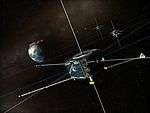
.jpg)

